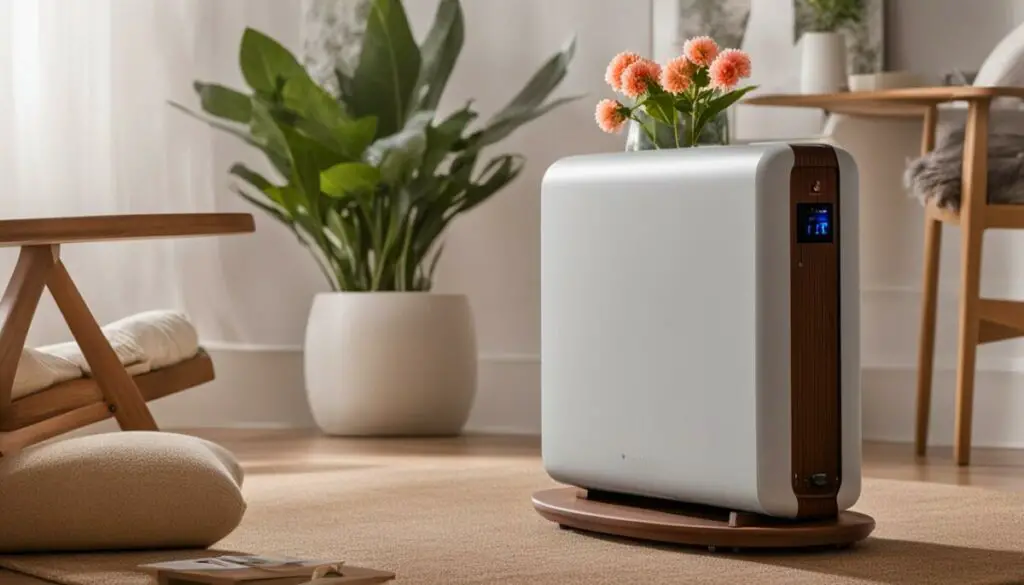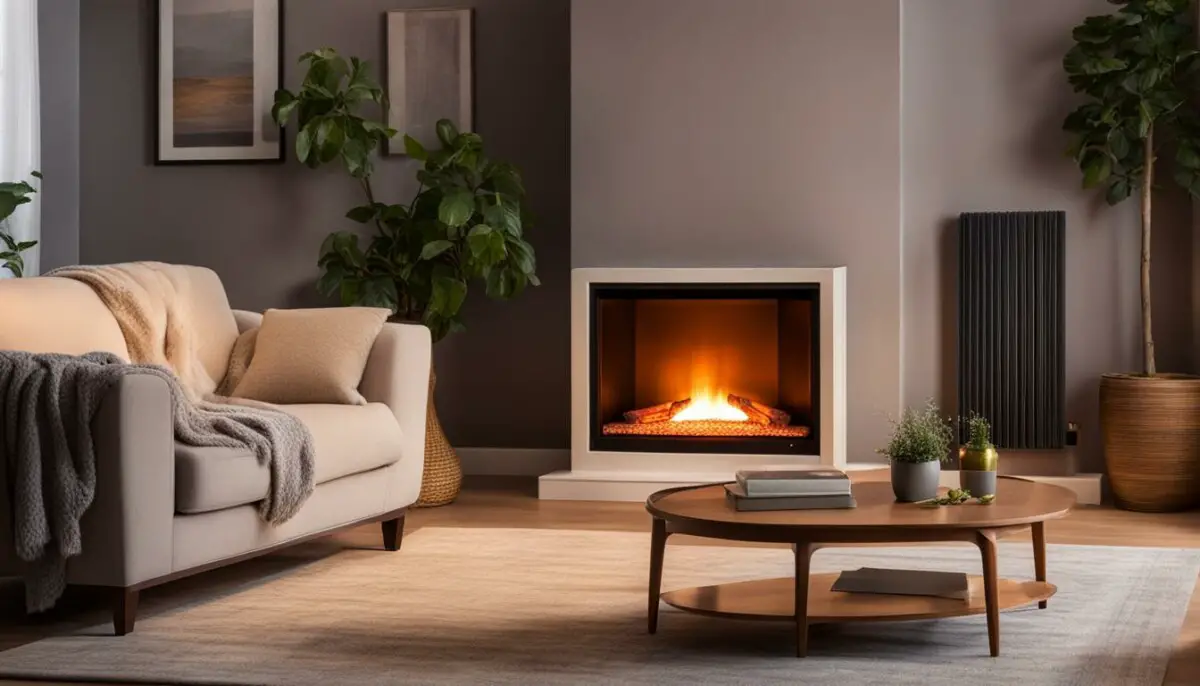Last Updated on 6 months by Francis
As winter approaches, many of us are looking to find the most efficient and comfortable way to heat our homes. The use of infrared heaters has become increasingly popular, thanks to their energy efficiency and ability to provide a comfortable heat without the need for a traditional heating system. However, there is a common question that often arises when considering infrared heaters – do they dry out the air in your home?
In this article, we will explore the impact of infrared heaters on air moisture levels and their effect on indoor air quality. We will delve into the science behind infrared heating, examine the ideal indoor humidity levels, and provide guidance on maintaining a healthy air moisture balance when using infrared heaters.
Contents
Key Takeaways:
- Infrared heaters provide an efficient and comfortable way to heat homes
- Many people wonder if infrared heaters have a drying effect on the air
- It’s important to understand the role of air moisture in maintaining healthy indoor air quality
- By understanding the science behind infrared heating, we can better analyze its effect on air drying and moisture loss
- Maintaining a healthy air moisture balance is crucial when using infrared heaters
Understanding Infrared Heaters

Before we can explore whether infrared heaters have a drying effect on the air, it’s important to understand what they are and how they work. Infrared heaters are a type of electric heater that produce heat by emitting infrared radiation. This radiation is absorbed by objects and surfaces in the room, which then radiate heat back into the air, creating a more comfortable and even warmth.
Infrared heaters are often preferred over other types of heaters because they can be more energy-efficient and provide heat more quickly. They are also known to produce less noise and circulate less dust than forced-air heaters.
There are three main types of infrared heaters: quartz, ceramic, and carbon. Quartz heaters use quartz tubes to produce heat, while ceramic heaters use ceramic elements. Carbon heaters use panels made of carbon fiber to generate heat.
One of the benefits of infrared heaters is that they don’t dry out the air like some other types of heaters, such as forced-air heaters. This is because they heat objects and surfaces rather than the air itself, which helps to maintain a comfortable level of humidity in the room.
How Do Infrared Heaters Compare to Other Types of Heaters?
When it comes to overall efficiency and cost-effectiveness, infrared heaters are often considered a top choice. They are more energy-efficient than traditional heaters, as they don’t waste energy heating the air, but rather heat objects and surfaces directly. This means that they can provide heat more quickly and maintain a more comfortable temperature with less electricity.
Another benefit of infrared heaters is that they tend to last longer than other types of heaters, as they don’t have moving parts that wear out over time. They also produce less noise and require less maintenance than other types of heaters, which can make them a more convenient and hassle-free option.
Overall, if you’re looking for a reliable, energy-efficient, and low-maintenance heating solution, infrared heaters are definitely worth considering.
The Role of Air Moisture

Indoor air quality is heavily influenced by the amount of moisture present in the air. The ideal indoor humidity levels range from 30% to 50%. While high humidity levels can lead to mold and mildew growth, low humidity levels can cause dry skin, sinus congestion, and other respiratory problems. Maintaining a healthy air moisture balance is crucial for optimal indoor air quality.
When it comes to heating and air moisture, traditional heating methods have a drying effect on the air due to the continuous circulation of warm air. As warm air rises, it displaces cooler air, creating a cycle that can cause a reduction in humidity over time.
However, infrared heaters work differently. They heat objects directly, rather than the air. This means that the air remains stationary, and there is no continuous circulation that can cause moisture loss. In fact, infrared heaters have been shown to increase air moisture levels slightly due to the heat generated by the objects they are warming.
While infrared heaters do not directly affect air moisture levels, it’s still important to monitor humidity levels and maintain a healthy air moisture balance. One way to do this is to use a humidifier in conjunction with your infrared heater. Adding moisture to the air can help to counteract any drying effects and improve indoor air quality.
“Maintaining a healthy air moisture balance is crucial for optimal indoor air quality.”
How Infrared Heaters Work

To understand how infrared heaters affect air moisture, it’s important to grasp the mechanism behind how they generate heat. Unlike traditional heaters, which warm the air around them, infrared heaters emit infrared radiation that heats objects in their path, including people and furniture. This process is similar to the way sunlight heats the Earth.
Because infrared heaters don’t heat the air directly, they don’t affect air moisture levels in the same way as other heaters. Instead, they produce a gentle, warming heat that feels comfortable without causing air dryness.
“Infrared heaters are a popular choice for people who want a comfortable, energy-efficient heating option that doesn’t dry out the air.”
Another advantage of infrared heaters is that they don’t release any pollutants or allergens into the air, making them a safer option for people with respiratory issues. They also require less energy to operate than other heating options, making them a more eco-friendly choice.
The Infrared Heater Effects on Air Moisture
Infrared heaters have a minimal effect on air moisture levels, as they don’t add or remove moisture from the air. However, they can affect the distribution of moisture in a room. Infrared heaters work by directly heating objects, so they don’t warm the air around them as much as traditional heaters. As a result, the air near the floor may be cooler than the air near the ceiling, which can cause uneven moisture distribution.
For people who want to maintain a consistent air moisture balance, it’s important to use infrared heaters in conjunction with a humidifier. This will help ensure that the air in your home stays at a healthy level of humidity, promoting optimal indoor air quality.
Effects of Infrared Heating on Air Moisture

Now that we understand the science behind infrared heaters, let’s explore their impact on air moisture levels. One common concern is whether these heaters have a drying effect on the air, leading to moisture loss.
While infrared heaters do not directly remove moisture from the air, they can indirectly affect air moisture in certain circumstances. When an infrared heater warms up a room, it can cause the air to expand and rise, which draws in cooler, drier air from outside. As a result, the humidity levels in the room may decrease slightly.
However, this effect is usually minimal and temporary, as long as the room is adequately sealed and insulated. Additionally, some infrared heaters come with built-in humidifiers to counteract any potential moisture loss.
To avoid any issues with air drying or moisture loss, it’s important to maintain a healthy air moisture balance in your home. This can be achieved by using a hygrometer to monitor indoor humidity levels and adjusting your heater settings accordingly. Ideally, indoor humidity should be between 30% and 50%.
If you live in an extremely dry climate, you may want to consider using a humidifier in conjunction with your infrared heater to maintain a healthy air moisture balance.
Overall, while infrared heaters may have a slight impact on air moisture levels, this effect is typically minimal and can be easily managed with proper maintenance of the room and monitoring of humidity levels.
Table: Comparing Infrared Heating to Other Heating Options
| Heating Option | Air Quality | Air Drying/Moisture Loss | Energy Efficiency |
|---|---|---|---|
| Central Heating | Can distribute allergens and pollutants | May cause dry air in certain conditions | Less efficient than targeted heating |
| Space Heaters | Can be a fire hazard if not used properly | May cause dry air in certain conditions | Less efficient than targeted heating |
| Infrared Heating | No impact on air quality | May cause slight moisture loss in certain conditions | More efficient than traditional heaters |
“While infrared heaters may have a slight impact on air moisture levels, this effect is typically minimal and can be easily managed with proper maintenance of the room and monitoring of humidity levels.”
When comparing infrared heaters to other heating options, it’s clear that they offer several advantages in terms of air quality and energy efficiency. While they may cause some moisture loss in certain conditions, this effect is typically minimal and can be easily managed.
Maintaining Indoor Air Quality with Infrared Heaters

While infrared heaters offer many benefits, it’s important to use them responsibly to maintain the air quality in your home. Here are some tips to ensure optimal indoor air quality:
- Keep the air moisture balance in check: Because infrared heaters can potentially dry out the air, it’s essential to monitor the humidity levels in your home. Investing in a hygrometer can help you keep track of the air moisture levels and ensure you maintain a healthy balance.
- Use a humidifier: If you notice that the air in your home is getting too dry, consider using a humidifier. This will help replenish the moisture in the air and create a comfortable living environment.
- Keep your home well-ventilated: Proper ventilation is key to maintaining good indoor air quality. Be sure to keep windows open, use exhaust fans, and ensure proper air circulation throughout your home.
- Invest in a high-quality air filter: Using a high-quality air filter in your heating and cooling system can help capture small particles that may affect your indoor air quality.
By following these tips, you can ensure that your infrared heater provides comfortable and healthy heat for you and your family.
Comparing Infrared Heaters to Other Heating Options
Compared to traditional heating options, infrared heaters can offer a more efficient and cost-effective way to heat your home. Because infrared heaters directly heat objects and people, rather than the air around them, they can provide heat more quickly and efficiently. This also means that less energy is wasted heating the air, resulting in lower energy bills.
Additionally, infrared heaters have the potential to improve indoor air quality. Because they don’t rely on forced air to circulate heat, they don’t spread allergens and other pollutants throughout your home. And, as we’ve discussed, by being mindful of air moisture levels, you can avoid any negative impact on indoor air quality.
Overall, infrared heaters offer a safe and effective way to heat your home while maintaining good indoor air quality. By taking the necessary precautions and investing in a high-quality heater, you can enjoy the many benefits of infrared heating.
Debunking Common Myths

There are several myths surrounding infrared heaters and their impact on air moisture and indoor air quality. Let’s explore and debunk them:
Infrared heaters dry out the air
One of the most common myths about infrared heaters is that they dry out the air, leading to discomfort and health concerns. However, this is not entirely accurate. While infrared heaters do reduce humidity levels, they do not necessarily dry out the air to the point of discomfort or health risks if used correctly.
Infrared heaters negatively impact indoor air quality
Another myth surrounding infrared heaters is that they compromise indoor air quality by releasing harmful emissions. This is not true. Because infrared heaters do not rely on combustion to generate heat, they do not emit harmful gases or pollutants.
Infrared heaters are the best option for maintaining optimal humidity levels
While infrared heaters can help regulate humidity levels in your home, they are not necessarily the best option for doing so. Other heating methods, such as steam heat or radiant floor heating, can also help maintain optimal humidity levels and promote healthy indoor air quality.
By debunking these myths, we can better understand the true impact of infrared heaters on air moisture and indoor air quality. It’s important to make informed heating decisions based on accurate information and not succumb to common misconceptions.
Comparing Infrared Heaters to Other Heating Options
When it comes to heating your home, there are many different options to consider. From traditional furnaces to electric heaters, each type of heating system has its own set of advantages and disadvantages. So how do infrared heaters stack up against their counterparts when it comes to indoor air quality and air moisture?
One of the primary differences between infrared heaters and traditional heating systems is the way that they generate heat. Whereas traditional systems use forced air or heated water to warm up a room, infrared heaters emit radiation that directly heats up objects and surfaces in the room. This can lead to a more efficient and cost-effective heating process, as well as a reduction in air movement and circulation.
But what about the impact on indoor air quality and air moisture? Compared to traditional heating systems, infrared heaters tend to have a lesser effect on air moisture levels. Because they do not rely on air movement to distribute heat, there is less of a chance for moisture to be removed from the air and drawn towards the heater itself.
This can result in a more comfortable living environment with less dryness and skin irritation, especially during the winter when the air can become particularly dry. However, it’s important to note that maintaining a healthy air moisture balance is still crucial when using any type of heating system, including infrared heaters.
Overall, infrared heaters can be an excellent option for those looking to reduce energy costs and improve indoor air quality. While they may not be as effective at removing moisture from the air as traditional systems, their targeted heating approach can lead to a more comfortable and efficient living space.
Conclusion
After exploring the facts and examining the effects of infrared heaters on air moisture levels, we can conclude that they do not significantly dry out the air in your home. While they may reduce the moisture levels in the immediate vicinity of the heater, they do not have a widespread drying effect on the entire room.
It’s essential to maintain a healthy air moisture balance when using infrared heaters. By keeping the humidity levels within the recommended range of 40%-60%, you can ensure optimal indoor air quality. You can also employ strategies such as using a humidifier, keeping the room well-ventilated, and avoiding prolonged use of infrared heaters to maintain the air moisture balance.
Overall, infrared heaters are a safe and effective heating option that provides many benefits. By understanding the relationship between infrared heaters and air moisture, you can make informed decisions for your heating needs while preserving the quality of indoor air.
Thank you for reading!
FAQ
Do infrared heaters dry out the air?
No, infrared heaters do not dry out the air. Unlike traditional heaters, which can deplete the moisture in the air, infrared heaters work by heating objects directly rather than the air. This means that they do not affect the moisture levels in the room.
What are infrared heaters?
Infrared heaters are heating devices that use infrared radiation to generate heat. They emit rays that directly heat the objects in their path, providing warmth without heating the surrounding air.
What is the role of air moisture?
Air moisture plays a crucial role in maintaining indoor air quality. The ideal humidity levels for indoor spaces range from 40% to 60%. Proper air moisture balance ensures a comfortable living environment and can have positive effects on respiratory health and skin hydration.
How do infrared heaters work?
Infrared heaters work by emitting infrared radiation, which is absorbed by objects and surfaces in the room. These objects then release the absorbed heat into the surrounding air, creating a warm and cozy environment.
Do infrared heaters affect air moisture?
No, infrared heaters do not affect air moisture. Since they do not heat the air directly, there is no drying effect on the room’s humidity levels. This makes them a great option for maintaining a healthy air moisture balance while enjoying the benefits of infrared heating.
How can I maintain indoor air quality with infrared heaters?
To maintain indoor air quality with infrared heaters, it is essential to monitor the humidity levels in your home. Using a hygrometer can help you keep track of the moisture content in the air. Additionally, you can incorporate other strategies, such as using humidifiers or ensuring proper ventilation, to maintain a healthy air moisture balance.
Are there any common myths about infrared heaters and air moisture?
Yes, there are some common misconceptions surrounding infrared heaters and their impact on air moisture. One common myth is that they dry out the air, which we have clarified is not the case. It is important to separate fact from fiction to make informed decisions about heating options and their effects on indoor air quality.
How do infrared heaters compare to other heating options?
Infrared heaters differ from traditional heaters in terms of their impact on air moisture and overall air quality. Traditional heaters can dry out the air, while infrared heaters do not. By choosing infrared heaters, you can maintain a healthier air moisture balance in your home.
Do infrared heaters dry out the air?
No, infrared heaters do not dry out the air. Through our exploration of the facts, we have determined that they have no drying effect on the air in your home. You can confidently enjoy the benefits of infrared heating without worrying about compromising indoor air quality.








